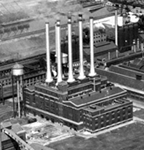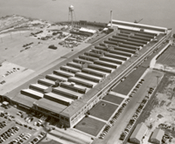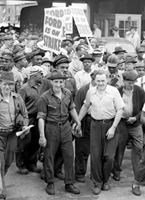
From Motor City to Motor Metropolis: How the Automobile Industry Reshaped Urban America
Moving Out: Decentralization and the Decline of Urban Factories
Even more momentous was the decentralization of automobile production. Already by the 1920s, Detroit's auto industry began to decentralize, locating new plants in outlying areas. But the pace of industrial flight picked up rapidly in the 1940s and 1950s, again reshaping the geography of Detroit and indeed of industrial America. Between 1945 and 1957, the Big Three auto companies built twenty-five new plants in metropolitan Detroit, all of them outside the city. Ford opened new plants in such places suburban Plymouth and Madison Heights, and in remote Wixom, thirty-five miles northwest of downtown. General Motors plants sprung up virtually overnight at sites in Livonia, Warren, and Romulus, all suburbs of the city. Even Chrysler, which did not have as much capital to build new plants, constructed several new suburban facilities. The new "greenfield" plants (so named because they were usually built on old farmland, woods, or marshes) were strikingly different in their layout and architecture from the old, brick-clad, multistory plants like Highland Park, Dodge Main, or River Rouge. Sprawling single story complexes, they were often elaborately landscaped and surrounded by vast parking lots.
Along with the auto plants, many smaller parts suppliers, machine shops, and tool-and-die firms relocated outside the city. Increasingly, such small shops were scattered around the small towns of the upper midwest, particularly in northern Indiana and Ohio. The spread of industrial jobs outside of central cities was not peculiar to the auto industry, to be sure. The mill towns of New England were gutted in the 1920s when textile manufacturers relocated to the low-wage markets of Virginia, North Carolina, and Georgia. Trenton, Philadelphia, and Camden witnessed a slow, steady hemorrhage of jobs outward. Garment shops that had once been in New York reappeared in small towns far from the Big Apple. But the impact of the auto industry's restructuring was particularly profound. In 1950, one-sixth of the nation's jobs were somehow related to the automobile industry. As the old adage went, when Detroit sneezed, the rest of the midwest got a cold.
The most gigantic of Detroit plants, Ford's vast River Rouge complex, was one of the first to decentralize. After Ford workers voted overwhelmingly to join the fledging United Automobile Workers union in 1941, Ford officials soon realized that their flagship production facility was particularly vulnerable to labor unrest. Rouge workers were among the industry's most well-organized, racially and ethnically diverse, and militant. When Rouge workers walked out on strike, the company's entire manufacturing operations crashed to a halt. To diffuse union power, to avail itself of new technologies, and to reach new markets, Ford relocated key operations outside of the Rouge plant, often setting up parallel production (two or more factories producing the same goods) to minimize the effect of wildcat strikes and walkouts. By 1960, only 30,000 worked at the Rouge. By 1990, its workforce had plummeted to just a little over 6,000. What had been done at the Rouge was now done in bits and pieces throughout the country in places as far-flung as Brook Park Village and Lima, Ohio, Buffalo, New York, and Richmond, California.
<<Previous Section - Next Section>>
Becoming the Motor City: Immigrants, Migrants, and the Auto Industry
Living in the Motor City: Autoworkers, Race, and Urban GeographyBuilding the Motor Metropolis: Automobiles, Highways, and Sprawl
Moving Out: Decentralization and the Decline of Urban Factories
Downsizing: Depopulation, Disinvestment, and the Fate of the City
Complete Text Printable View
About the Project | Credits | Contact Us | Student & Teacher Resources | Site Map
©2004 Automobile in American Life and Society





